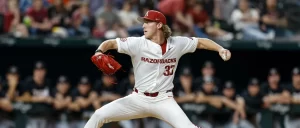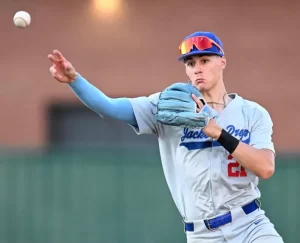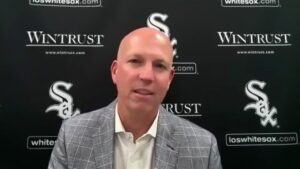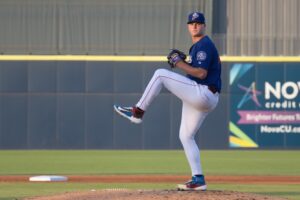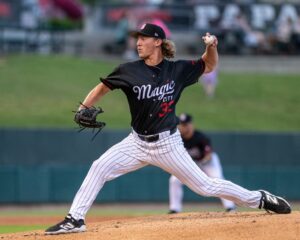Draft Preview: Carlos Rodon

Carlos Rodon
School: North Carolina State
Position: LHSP
Height/Weight: 6’3”/234
B/T: L/L
D.O.B.: 12/10/1992
Previously Drafted: 2011- 16 (491) by Milwaukee Brewers
Scouting Reports:
High School:
“When he’s on, he features an 88-92 mph fastball, a curveball and slider with solid command. The slider is arguably his best secondary pitch, and both pitches are sharp and show plus potential.” –Baseball America
Rodon was not considered one of the top prep arms out of high school in 2011, with Dylan Bundy and Archie Bradley leading the class, after some injury problems affected his velocity, but Rodon was still seen as someone who could go in the top 4 rounds. He ended up falling to the 16th round and rejected a $500k offer from the Brewers.
College:
Freshman– Rodon won Baseball America’s freshman of the year award in 2012 after he compiled 135 K/41 BB in 115 IP for N.C. State. He saw a big jump in velocity that year too, with Baseball America writing the following:
“Thanks to a rigorous strength and conditioning regimen, Rodon’s fastball velocity jumped from 88-92 mph in high school to hitting 96-97 during intrasquad scrimmages. This spring, he regularly sat between 92-95 and even hit 99 a handful of times.”
Sophomore– Rodon struck out 184 batters in 2013, giving him the seventh highest single season strikeout total for a college pitcher since 2000, putting him in fine company with the likes of David Price, Stephen Strasburg, Tim Lincecum, Mark Prior, Trevor Bauer and Jered Weaver. At this point Rodon was showing a mid 90’s fastball, knockout slider and solid average change, all with better than average command, leading to many calling Rodon the best college lefty since David Price.
Junior– Unfortunately for Rodon his junior season has not been quite so impressive. His velocity often hovered around the 89-92 mph range early in the year, well down on the 93-95 mph heat he was throwing as a sophomore, and his command of the pitch has also been lacking at times. His slider is still a plus-plus pitch, but hasn’t always looked at its best according to reports. Perhaps most worrying though has been the absence of his change, which he has not been throwing a lot this year. That’s the one pitch that will really need work going forward. It’s not all bad though, as Rodon has shown at least flashes of his best this year, with his velocity returning as the season has gone on, and his overall arsenal still ranks at the top of this draft class. Rodon has also been noted for his supreme competitiveness.
Scouting Grades:
Note: these grades are my summations based on all readily available scouting information from sources such as Baseball America, MLB.com and ESPN:
Fastball: 60/65
Slider: 70/70+
Change: 45/60
Command: 45/60
Overall: 65
Prospect Overview and Future Outlook:
Carlos Rodon was considered a lock to 1-1 entering this season, but he’s had an up-and-down year, bringing him back to the pack. His velocity and fastball command have been inconsistent and he’s been heavily relying on his slider. His college coach offered some suggestions to explain his poor early season showing, such as exceptionally cold/poor weather and less than ideal preparation for the season after Rodon pitched for Team USA.
Rodon’s also been worked hard this year racking up some incredibly high pitch counts (130+), which could be of concern going forward, though it is not particularly uncommon to see in college. His heavy slider usage could also be of concern as there are those who believe that extreme use of the pitch can lead to injuries down the road. He’s also a confident (perhaps cocky) guy, and has been quoted as saying he believes he could pitch in MLB today. This could be a positive or negative, depending on how you like to look at it.
Rodon’s upside is terrific, and is perhaps higher than that of anyone else in this draft class. His slider may also be the single best pitch in this draft class too, and it has received 80 grades from scouts in the past when it’s been on. Whichever team drafts him will likely focus on improving Rodon’s command and changeup as this would help Rodon to realize his potential as a true Major League ace. If Rodon’s command and change cannot get to the requisite standard, his fastball/slider combo should easily allow him to close games, though that would be a worst case scenario.
Is Rodon signable at #3?
Being advised by the Scott Boras Corp. naturally, many of the questions about Rodon are in regard to his signability. The fear among many fans is that if the Sox take him at #3, will they actually be able to sign him? With the new draft bonus format, it is much more difficult for teams to go significantly over-slot with their first round picks. If Boras is to demand 1-1 money for Rodon it would put the Sox in a difficult position. The Sox have a draft pool of $9,509,700 and the slot recommendation for the 1-1 pick is $7,922,100, so they could offer Rodon 1-1 money, but it would leave them with just $1,587,600 for the remainder of the draft. This would allow the Sox to sign their second round selection for slot ($1,282,700) with around $300,000 remaining, which is significantly less than the slot recommendation for their third round pick ($726,000).
We can use the Mark Appel situation as a comparison for Rodon. Appel, also a Boras client, was expected to go 1-1 in 2012, but slipped to the Pirates at 1-8 and elected not to sign after being offered $3.8m. The Pirates’ offer was $900k above slot value for the 1-8 pick, but still just over half the slot value for the 1-1 pick that year of $7.2m. Appel went back to school and ended up as the 1-1 pick for the Astros in 2013. Still advised by Boras, Appel actually received a below slot bonus of $6.35m, which was $1.44m below the slot recommendation of $7,790,400, and was actually less than 1-2 pick Kris Bryant (also a Boras client) received from the Cubs ($6,708,400). This shows that seniors will typically have less leverage. If you don’t sign as a senior then you’re likely facing the prospect of Independent League baseball a la Aaron Crow in 2008.
The point I’m trying to illustrate is that I think the Rodon signability questions are overblown. If the Sox take him at #3 he should definitely be signable and for somewhere close to the slot value of $5,721,500. Perhaps they would have to go a little over-slot, to somewhere in the $6-6.3m range, but nothing that would hamstring them for the rest of the draft. They could also get creative with the contract similar to what they did with Chris Sale, and guarantee Rodon a quick ascent to the Majors in return for signing closer to slot.

